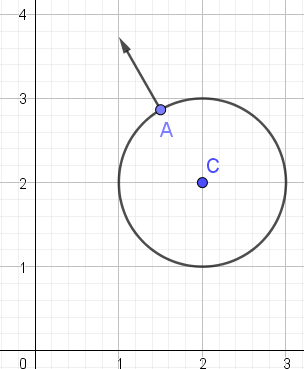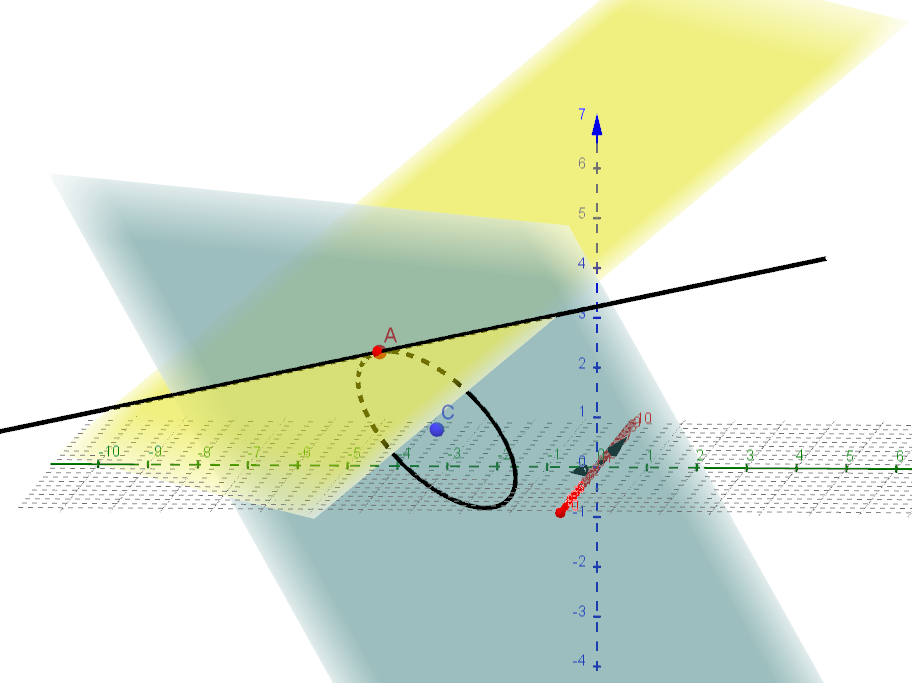Normal to a Circle in the Plane
Tangent and Normal using Cartesian Coordinates
Disclaimer: Cartesian coordinates in 3d describe surfaces, not curves.
A circle is a curve and furthermore, it is always in some plane. In
this section we are only going to consider a circle in the $xy$ plane.
By using rotation and translation, we could put any circle into the
$xy$ plane and then having found the tangent and normal, reverse
the operations, applying them to the newly found objects. We aren't
going to do that here either.
Tangent and Normal using Cartesian Coordinates
Disclaimer: Cartesian coordinates in 3d describe surfaces, not curves. A circle is a curve and furthermore, it is always in some plane. In this section we are only going to consider a circle in the $xy$ plane. By using rotation and translation, we could put any circle into the $xy$ plane and then having found the tangent and normal, reverse the operations, applying them to the newly found objects. We aren't going to do that here either.In Cartesian coordinates our circles is \[ \left(x-h\right)^{2}+\left(y-k\right)^{2}=r^{2} \] The constants, $(h,k)$ are the $x$ and $y$ coordinates of the circle center. The value $r$ is the circle radius. In standard form, the circle equation becomes \[ x^{2}+y^{2}-2hx-2ky=r^{2}-h^{2}-k^{2}. \] For finding the tangent and then the normal (the perpendicular), we usually use derivatives and they might be slightly easier in the standard form.
Tangent using Parametric Coordinates
In parametric coordinates, a circle with radius $R,$ about center point, $C,$ in a plane with basis vectors $\mathbf{u}$ and $\mathbf{v}$ is defined by \begin{equation} \mathbf{X}=C+R\cdot\cos\theta\cdot\mathbf{u}+R\sin\theta\cdot\mathbf{v}.\label{eq:GeneralParametricCircle} \tag{EQ 1} \end{equation} I have used $\mathbf{X}$ to represent either a $2$ or $3$ dimensional vector. $\theta$ is the parameter and spans $2\pi.$ We are considering vector functions of the type $\mathbb{R}\rightarrow\mathbb{R}^{(2\text{ or }3)}$. Our generalized vector function will be named $\mathbf{r(t)}.$ Its first derivative is the tangent. \[ \mathbf{r'}=\left\{ \frac{\partial r_{1}}{\partial t},\frac{\partial r_{2}}{\partial t},\frac{\partial r_{3}}{\partial t}\cdots\right\} \] Although the vector function derivative is general to $n$ dimensions, we are only to consider $\mathbb{R}^{2}$ and $\mathbb{R}^{3}.$ Let $\mathbf{r}$ be the parametric circle of \ref{eq:GeneralParametricCircle}. We need to identify $r_{1}(t),$$r_{2}(t)$ and $r_{3}(t).$ \[ \mathbf{r}=\left(\begin{array}{c} r_{1}\\ r_{2}\\ r_{3} \end{array}\right)=\left(\begin{array}{c} C_{x}\\ C_{y}\\ C_{z} \end{array}\right)+R\cdot\cos\theta\cdot\left(\begin{array}{c} u_{x}\\ u_{y}\\ u_{z} \end{array}\right)+R\cdot\sin\theta\cdot\left(\begin{array}{c} v_{x}\\ v_{y}\\ v_{z} \end{array}\right) \] \[ \mathbf{r^{\prime}=}\left(\begin{array}{c} r_{1}^{\prime}\\ r_{2}^{\prime}\\ r_{3}^{\prime} \end{array}\right)=-R\cdot\sin\theta\cdot\left(\begin{array}{c} u_{x}\\ u_{y}\\ u_{z} \end{array}\right)+R\cdot\cos\theta\cdot\left(\begin{array}{c} v_{x}\\ v_{y}\\ v_{z} \end{array}\right) \] Once $\theta$ is given a value, $\mathbf{r^{\prime}}$ resolves into a single $3$ element vector. That vector is the direction vector of the tangent line. \[ \mathbf{r^{\prime}=\text{Tangent Line Direction Vector}} \] The tangent line itself is the usual \[ \text{Line(x,y,z)}=P(\theta)+t\mathbf{\cdot r^{\prime}}(\theta)\qquad\left(-10\le t\le10\right) \label{EQ2} \tag{EQ 2} \] Here, $P$ is a point on the circle and $\theta$ is the parameter used to get both the point and the tangent vector. In equation \ref{EQ2}, $P(\theta)$ and $\mathbf{r^{\prime}}(\theta)$ are function notation.
Answer: We just need to copy the equations above and substitute values in place of variables. Notice that these basis vectors are the $xy$ plane. \[ Circle=\left(\begin{array}{c} 2\\ 2\\ 0 \end{array}\right)+2\cos t\cdot\left(\begin{array}{c} 1\\ 0\\ 0 \end{array}\right)+2\sin t\cdot\left(\begin{array}{c} 0\\ 1\\ 0 \end{array}\right)\qquad-\pi\le t\le\pi\Leftarrow\text{Just draws the circle} \] \[ \mathbf{u=}\left(\begin{array}{c} 1\\ 0\\ 0 \end{array}\right)\qquad\mathbf{v}=\left(\begin{array}{c} 0\\ 1\\ 0 \end{array}\right)\qquad-\pi\le q\le\pi\qquad C=\left(\begin{array}{c} 2\\ 2\\ 0 \end{array}\right) \] \[ \mathbf{r^{\prime}}(q)=-2\sin q\cdot\mathbf{u}+\cos q\cdot\mathbf{v}\quad\Leftarrow\text{a vector} \] \[ P(q)=C+2\cos q\cdot\mathbf{u}+2\sin q\cdot\mathbf{v}\Leftarrow\text{a point on the circle} \] \[ Tangent(q)=P(q)+t\cdot\mathbf{r^{\prime}}(q)\qquad-\infty\le t\le\infty\Leftarrow\text{The tangent line} \]
Normal using Parametric Coordinates
Normal in 2d
The normal is just a perpendicular to the tangent line at the tangent point. If we are in $\mathbb{R}^{2},$ we would do it as usual and just get a ``normal'' vector by swapping the $x$ and $y$ vector coordinates and changing the sign of one of them. So \[ \mathbf{r^{\prime}}=\left(\begin{array}{c} r_{x}^{\prime}\\ r_{y}^{\prime} \end{array}\right) \] then \[ \text{normal vector}=\mathbf{n}=\left(\begin{array}{c} r_{y}^{\prime}\\ -r_{x}^{\prime} \end{array}\right) \] Then, using the parameter $q$ from the prior example, the normal line is then \[ Normal(q)=P(q)+t\cdot\mathbf{n}(q)\qquad-\infty\le t\le\infty\Leftarrow\text{The normal line} \]

